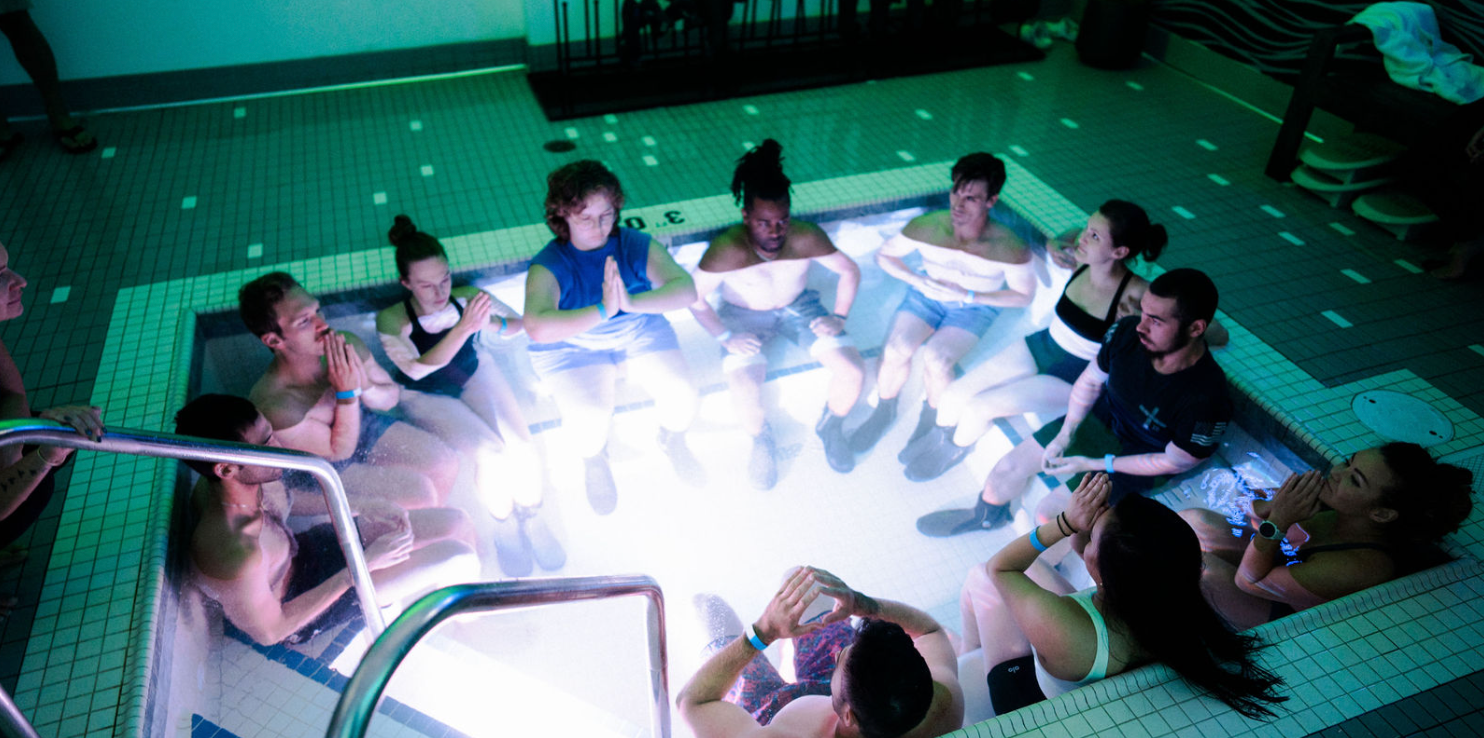From Flight & Fright to Calm & Relaxed
Ever notice how some people seem unbreakable under pressure, almost as if stress bounces right off them? Their secret isn’t magic or mutant DNA – it’s their nervous system and how they regulate it. Because learning how to tap into your nervous system is the ultimate secret weapon for combatting the chaos of daily life!
By the end of this post, you’ll see how deliberate cold exposure can transform your “fight-or-flight” response into a force for focus and calm. We’ll break down the science of your autonomic nervous system, explain what happens from the moment you step into an ice bath to the Zen-like high that follows, and show why your nervous system just might be your greatest untapped asset.
So take a deep breath (you’ll need it!) and let’s dive in – literally – to unlocking your nervous system’s potential.

Meet Your Autonomic Nervous System:
Your autonomic nervous system (ANS) is the part of your nervous system that runs on autopilot, controlling things like heart rate, breathing, and digestion without you having to think about it. It has two main branches with very different jobs:
-
Sympathetic Nervous System (SNS) – This is your “fight or flight” mode. When you’re in danger or under stress, the SNS hits the gas. Heart rate and blood pressure go up, breathing gets faster, and your body releases stress hormones like adrenaline. Blood rushes to your muscles – all primed to help you sprint away or battle a threat (clevelandclinic.org). Essentially, the SNS turns you into a short-term survival machine: alert, energized, and ready for action.
-
Parasympathetic Nervous System (PNS) – This is your “rest and digest” mode. It’s like the brake pedal that calms everything down. The PNS slows your heart rate, deepens your breathing, and redirects blood flow back to digestion and recovery. When the parasympathetic system is active, your body can relax, repair, and recharge after a stressful event (clevelandclinic.org). You feel safe and at ease – this is the state of calm and healing.
Sympathetic Overdrive
Normally, your SNS & PNS work in a balanced rhythm to keep you alive and well. The trouble is, in our modern world, many of us live with the “fight or flight” switch stuck in the “ON” position. Daily hassles, big workloads, constant notifications – our bodies register them all as stress.
Most of us live in a constant state of sympathetic overdrive—emails, deadlines, social pressures, traffic, and daily stressors keep our nervous system revved up. In fact, according to The Occupational Safety and Health Administration (OSHA) 83% of US workers suffer from work-related stress and 54% of workers report that work stress affects their home life (osha.gov). And burnout is all too real of a threat as well: A LinkedIn survey involving over 16,000 U.S. workers revealed that approximately 40% are experiencing burnout in their jobs (LinkedIn.com). Over time, this leads to chronic stress, anxiety, poor sleep, and other negative health outcome that really destroy our quality of life.
But here's the kicker: Cold exposure trains your nervous system to shift between your sympathetic and parasympathetic states effectively so that your body can better regulate its stress response.
Cold Plunge 101: From Fight-or-Flight to Chill-and-Relax
Imagine sitting submerged up to your chest in a freezing cold plunge tub. Every nerve ending on your skin screams “Get out!” Your heart starts pounding; your breathing becomes quick and shallow. This is the SNS – fight or flight – firing off. And it happens immediately when you hit cold water: studies show cold exposure causes an acute surge in heart rate, blood pressure, and breathing rate, along with a spike in stress hormones like norepinephrine (noradrenaline), which increases by 530% (journals.plos.org). In other words, your body reacts as if you’ve been dropped into an emergency state like a bear or a great white shark is attacking you. That sudden cold shock is your physiology’s ancient survival reflex.
Don’t panic – this intense feeling is exactly the point. In those first few seconds of a cold plunge, you’re face-to-face with your fight-or-flight reflex. As one neuroscience expert describes, “the first seconds in the water can be profoundly overwhelming” – you might feel a jolt of panic, gasp for air, and have an almost irresistible urge to jump out (psychiatrypodcast.com). This is a totally natural response. But here’s where the magic happens: you choose to stay. You steady your breathing, focusing on long exhales, and tell your mind that you’re safe. Breath by breath, your heart rate starts to steady. That roaring panic subsides, and a surprising wave of calm begins to wash over you. Because once you understand the breath, you are able to take back control. Every inhalation is a sympathetic event in your body, and every exhalation is a parasympathetic event. So long drawn out exhales from the nose will reel that nervous system back into a state of calm.
The Vagus Nerve: Unlocking “Rest-and-Digest” Mode
How exactly does the cold turn on the relaxation response? Meet your vagus nerve, a.k.a. the “chill out” nerve. This wandering nerve runs from your brainstem down into your chest and abdomen, connecting to your heart, lungs, and gut. It’s the major highway of your parasympathetic nervous system – and when you exhale slowly and deeply, the vagus nerve fires, telling your body “All is well, calm down now.” Activating the vagus nerve is like hitting the reset button on stress: heart rate drops, blood pressure lowers, and you feel calmer (pmc.ncbi.nlm.nih.gov).
And here's the cool part: Vagal tone is directly linked to emotional resilience and self-regulation. People with higher vagal tone (often measured by heart rate variability) tend to be more adaptable in the face of stress and have better control over their emotional responses frontiersin.org. By training your vagus nerve through cold plunges, you’re not just toughing out the ice water – you’re literally teaching your nervous system how to stay cool under pressure, whether it’s a cold tub or a heated meeting. That means less anxiety, more emotional balance, and a quicker return to calm after life’s surprises.
Brain Chemistry Boost: Norepinephrine, Dopamine, and the Feel-Good Cocktail
If the vagus nerve is the steering wheel for shifting state, neurochemicals are the fuel – and cold exposure causes an octane boost for your brain. When you immerse in cold water, your body releases a flood of neurotransmitters and hormones that have potent effects on your mood, focus, and energy. It’s like a natural pharmacology lab kicking into gear – no pills needed!
One of the star players here is norepinephrine (also known as noradrenaline). This neurotransmitter/hormone spikes dramatically during cold exposure – research shows that norepinephrine can increase 2-3 fold above baseline from a cold plunge and remain elevated for hours afterward psychiatrypodcast.com. That’s huge. Norepinephrine is associated with alertness, attention, and mood regulation. The surge you get from cold water will make you feel intensely awake and focused – many people describe an almost euphoric clarity after a cold bath. In fact, scientists have suggested that this big blast of norepinephrine in the brain may be one reason cold therapy can alleviate depression and anxiety symptoms (it’s similar to the mechanism of certain antidepressant medications )capitolfloats.com. Harvard researchers have noted that consistent cold water immersion tends to lower baseline cortisol (the chronic stress hormone) and raise norepinephrine and endorphins, which can improve mood and stress resilience longevity.stanford.edu.
Cold plunging also triggers the release of dopamine, our brain’s reward and motivation chemical. One famous finding (often cited by Dr. Huberman) is that an hour in moderately cool water (~60°F/15°C) can boost dopamine levels by 250% and keep them up for five to six hours post plunge hubermanlab.com. Even shorter cold exposures cause a significant dopamine rise – contributing to that post-plunge “natural high.” Dopamine elevation translates to improved mood, increased motivation, and even enhanced focus. It’s like a reset for your brain’s pleasure centers – many people report feeling extremely positive and optimistic after a cold dip, thanks to this neurochemical rush.
And let’s not forget endorphins – the body’s natural painkillers and mood elevators. Cold exposure causes the release of endorphins (similar to a runner’s high), which can lead to feelings of well-being and reduced pain perception. Peer-reviewed studies out of Stanford summarize that cold water immersion can improve mental health partly by increasing endorphins and norepinephrine together longevity.stanford.edu.
In essence, a cold plunge induces a powerful neurochemical cocktail: high norepinephrine, high dopamine, plus endorphins, and even a bit of serotonin. That post-plunge bliss is a natural and reliable way to create your state!
Ready to Take Control of Your Nervous System?
If it’s your first time plunging, don’t sweat it (unless you’re hitting the sauna first 😉).
We’ve guided over 350,000 people through their first cold plunge — and you’re next.
Our cold-certified, inspiring instructors will walk you through everything you need to know: the science, the breathing techniques, the mindset shifts — all designed to help you crush your first plunge and experience the incredible benefits of contrast therapy.
Whether you’re here to boost your resilience, sharpen your mental clarity, or just do something absolutely EPIC — this is your sign. It’s time to take the plunge.
🔹 Book your plunge credit now and start training your nervous system today!
🔹 Experience the power of cold — and discover what you’re capable of.
Note: Always consult with a healthcare professional before beginning any new wellness practice, especially those involving extreme temperatures.

Shira Shane
Creative Director of Breathe Degrees, Director of Breathwork & Contrast Therapy Training
Breathe Degrees & XPT Certified Breath Coach






